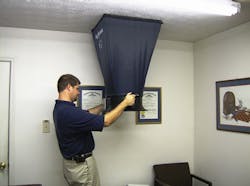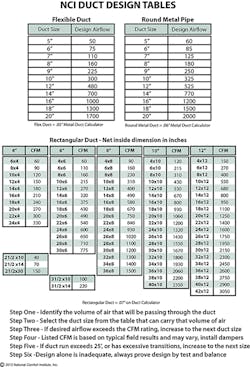A Five Minute Duct Pressure Test
This quick and simple test method allows you to assess the performance of supply and return ducts by measuring duct system pressures. Then compare the pressure to a duct system pressure budget. If the pressure is higher than the budget, the ducts may be too restrictive to airflow
Step One - Drill two 3/8" test holes just before and after the air moving equipment; One in the supply duct and one in the return duct.
Step Two - Connect a pressure hose to a low pressure manometer at one end and to a static pressure tip at the other end.
Step Three - Read and record supply and then return duct pressure. Compare them to 50% of the maximum rated fan pressure at the specified system airflow.
If the system has an external cooling coil, the supply or return duct system pressure is only allowed 25% of the maximum-rated fan pressure each. If there are return air filter grilles, the pressure of the filters must be excluded from the return duct pressure.
Low Pressure Duct Chart
National Comfort Institute (NCI) has a software tool called ComfortMaxx for HVAC professionals to use to measure, record, and diagnose the performance of HVAC systems all over the country, every day.
Because we have access to this data, we can "see" duct system performance like never before. Using this data, NCI has created duct sizing tables that realistically indicate typical airflows. We have listed duct types and sizes and published actual measured delivered airflow that you can use to check existing duct sizes in the field.
Bottom line, ducts deliver far less airflow than what you think. From this data we have also learned that the typical system is operating at pressures more than 50% higher than the system fan ratings. In other words, we see lots of really low airflow.
So here’s what you should do: Inspect the ducts and record their size. Compare the required airflow to the listed airflow in the table as an indicator of an acceptable duct size. If the duct is undersized and attached to an uncomfortable room, increase the duct size or add an additional duct along with the equipment replacement.
If you are an HVAC contractor or technician, email Doc for a free NCI duct sizing table that you can use in the field.
Just Measure the Duct Airflow
Design, without verification is cheap. Design is what you hope will happen after the system is built. As soon as you get an air balance hood in your hands, you begin to understand what duct sizing and good installation is all about.
Using a good quality commercial air balance hood, measure and record each supply register and return grille airflow. Compare the actual airflow to the required airflow. Typical duct sizing and installation quality will deliver airflow that’s 25% to 50% below design in uncomfortable rooms.
You'll be surprised and a little angry at first, until you learn to see the opportunity in this situation. Every equipment change out usually needs several more ducts and a few upsized ducts to enable equipment to work as designed and deliver the comfort you promised.
Give one or all three of these duct sizing and performance test methods a field run and see what you learn about the size of your duct systems. Then begin to delight your customers by delivering the performance and efficiency you’ve always talked about.
Rob “Doc” Falke serves the industry as president of National Comfort Institute: a national training and membership organization. If you're an HVAC contractor or technician interested in a free NCI Duct Sizing Table contact Doc at [email protected] or call him at 800-633-7058. Go to NCI’s website at nationalcomfortinstitute.com for free information, articles and downloads.
About the Author
Rob 'Doc' Falke
President
Rob “Doc” Falke serves the industry as president of National Comfort Institute an HVAC-based training company and membership organization. If you're an HVAC contractor or technician interested in a building pressure measurement procedure, contact Doc at [email protected] or call him at 800-633-7058. Go to NCI’s website at NationalComfortInstitute.com for free information, articles and downloads.

